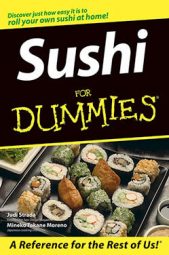Sushi is especially gorgeous when adorned with salmon roe — known for its showstopping size, orange-red color, and velvety texture. This easy Salmon Roe Battleship Sushi has only four ingredients, so it really highlights the look and taste of the roe.
Battleship sushi starts with regular finger sushi that you wrap with little nori strips, creating tiny sushi that look like — yes, you guessed it — battleships.
Salmon Roe Battleship Sushi
Preparation time: 15 minutes
Yield: 8 pieces
1 cup prepared sushi rice
1 sheet nori
3/4 teaspoon wasabi paste, or to taste
4 ounces salmon roe
Hand-shape a bite-size portion of the sushi rice into a little oval.
Press the bottom side of the sushi rice ball crosswise with your thumb.
This step gives the sushi ball a slight humped look.
Repeat Steps 1 and 2 to prepare 8 finger sushi.
Cut the nori into 8 strips, each 1 x 7 inches.
Wrap a strip of nori around the sides of each finger sushi, shiny side out, creating a tiny collar all around the rice.
Stick the nori closed with a grain of rice, if necessary.
Dab a little wasabi paste on top of the rice inside the nori collar.
Delicately spoon about 1 tablespoon of the salmon roe into each nori collar.
Serve immediately while the nori is crisp.
Per piece: Calories 64 (From fat 13); Fat 1g (Saturated 1g); Cholesterol 49mg; Sodium 34mg; Carbohydrate 7g (Dietary fiber 0g); Protein 3g.
Vary the roe that fills this battleship sushi for looks as well as flavor. Use wasabi tobikko (pale green), smelt roe (orange), or flying fish roe (reddish-orange).
Salmon roe is available at Asian markets, or you can order it by phone or online. It’s usually about $20 a pound, much less than other roe, such as true caviar.

